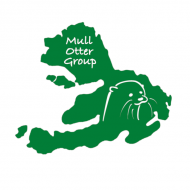?
?
What is a Mull Otter?
The otters on Mull mainly occupy areas of coastline, and find their prey in the sea. Because of this they are often referred to as sea otters which is incorrect, as sea otters are a different species found on the Pacific coast. The Mull otter is the Eurasian otter (Lutra lutra) which is the only species of otter in the UK, and is the same species as otters that occupy rivers and lakes throughout the country.
The Eurasian otter is a large mammal, a member of the Mustelid family, which also includes Badgers, Mink and Pine Marten.
An adult otter will weigh on average 7 – 10 kg and be about 1-1.2 metres long from tip of nose to end of tail. Dog otters are heavier and slightly longer than bitches and can also be identified by their thicker necks and square muzzles. The bitch has a more pointed face.
The otter’s coat is dark brown, often with creamy patches under the chin, which can extend to the throat and stomach. The coat is very thick and glossy and consists of two types of fur: the inner layer is a very fine but dense fur, approximately 70,000 hairs per square centimetre and the outer fur is the waterproof layer, which is kept well groomed to help repel water. When grooming, the otter will trap a layer of insulating air between its inner dense fur and the outer guard hairs.
The meticulous grooming habits of an otter ensure it is able to regulate its body temperature. It rarely remains in water for longer than an hour’s duration. When an otter comes onto the shore, the water runs off the outer guard hairs, which combine into small spikes. This is the sign of a healthy otter. An otter should only look sleek when it’s in the water; once on land it should exhibit its characteristic spiky appearance.
Otters have short legs and webbed feet with five clawed toes on each foot, which help the mammal to grip its prey securely in the water.
The Eurasian Otter has 36 teeth and typify an animal that has a predatory lifestyle. They have backwardly curved canine teeth for killing and holding slippery prey and sharp molars for cutting and grinding.
Further info..
Navigate to further information on otters:
